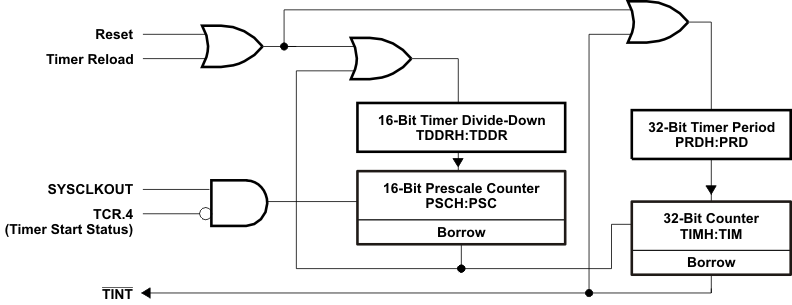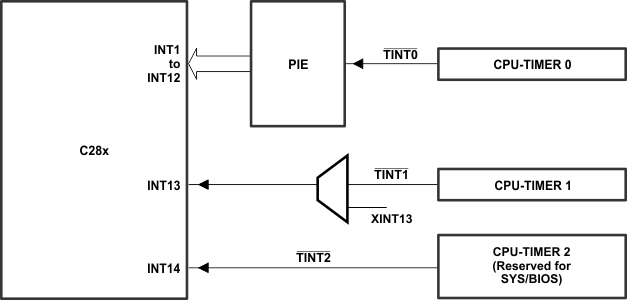SPRS357D August 2006 – June 2020 TMS320F28044
PRODUCTION DATA.
- 1Device Overview
- 2Revision History
- 3Device Comparison
- 4Terminal Configuration and Functions
-
5Specifications
- 5.1 Absolute Maximum Ratings
- 5.2 ESD Ratings – Commercial
- 5.3 Recommended Operating Conditions
- 5.4 Power Consumption Summary
- 5.5 Electrical Characteristics
- 5.6 Thermal Resistance Characteristics for F28044 100-Ball GGM Package
- 5.7 Thermal Resistance Characteristics for F28044 100-Pin PZ Package
- 5.8 Thermal Design Considerations
- 5.9
Timing and Switching Characteristics
- 5.9.1 Timing Parameter Symbology
- 5.9.2 Power Sequencing
- 5.9.3 Clock Requirements and Characteristics
- 5.9.4
Peripherals
- 5.9.4.1 General-Purpose Input/Output (GPIO)
- 5.9.4.2 Enhanced Control Peripherals
- 5.9.4.3 External Interrupt Timing
- 5.9.4.4 I2C Electrical Specification and Timing
- 5.9.4.5 Serial Peripheral Interface (SPI) Master Mode Timing
- 5.9.4.6 SPI Slave Mode Timing
- 5.9.5 JTAG Debug Probe Connection Without Signal Buffering for the DSP
- 5.9.6 Flash Timing
- 5.10 On-Chip Analog-to-Digital Converter
-
6Detailed Description
- 6.1
Brief Descriptions
- 6.1.1 C28x CPU
- 6.1.2 Memory Bus (Harvard Bus Architecture)
- 6.1.3 Peripheral Bus
- 6.1.4 Real-Time JTAG and Analysis
- 6.1.5 Flash
- 6.1.6 M0, M1 SARAMs
- 6.1.7 L0, L1 SARAMs
- 6.1.8 Boot ROM
- 6.1.9 Security
- 6.1.10 Peripheral Interrupt Expansion (PIE) Block
- 6.1.11 External Interrupts (XINT1, XINT2, XNMI)
- 6.1.12 Oscillator and PLL
- 6.1.13 Watchdog
- 6.1.14 Peripheral Clocking
- 6.1.15 Low-Power Modes
- 6.1.16 Peripheral Frames 0, 1, 2 (PFn)
- 6.1.17 General-Purpose Input/Output (GPIO) Multiplexer
- 6.1.18 32-Bit CPU-Timers (0, 1, 2)
- 6.1.19 Control Peripherals
- 6.1.20 Serial Port Peripherals
- 6.2
Peripherals
- 6.2.1 32-Bit CPU-Timers 0/1/2
- 6.2.2 Enhanced PWM Modules (ePWM1–16)
- 6.2.3 Hi-Resolution PWM (HRPWM)
- 6.2.4 Enhanced Analog-to-Digital Converter (ADC) Module
- 6.2.5 Serial Communications Interface (SCI) Module (SCI-A)
- 6.2.6 Serial Peripheral Interface (SPI) Module (SPI-A)
- 6.2.7 Inter-Integrated Circuit (I2C)
- 6.2.8 GPIO MUX
- 6.3 Memory Map
- 6.4 Register Map
- 6.5 Interrupts
- 6.6 System Control
- 6.7 Low-Power Modes Block
- 6.1
Brief Descriptions
- 7Applications, Implementation, and Layout
- 8Device and Documentation Support
- 9Mechanical, Packaging, and Orderable Information
パッケージ・オプション
デバイスごとのパッケージ図は、PDF版データシートをご参照ください。
メカニカル・データ(パッケージ|ピン)
- PZ|100
サーマルパッド・メカニカル・データ
- PZ|100
発注情報
6.2.1 32-Bit CPU-Timers 0/1/2
There are three 32-bit CPU-timers on the F28044 device (CPU-TIMER0/1/2).
CPU-Timer 0 and CPU-Timer 1 can be used in user applications. Timer 2 is reserved for SYS/BIOS. These timers are different from the timers that are present in the ePWM modules.
NOTE
If the application is not using SYS/BIOS, then CPU-Timer 2 can be used in the application.
 Figure 6-1 CPU-Timers
Figure 6-1 CPU-Timers In the F28044 device, the timer interrupt signals (TINT0, TINT1, TINT2) are connected as shown in Figure 6-2.

The general operation of the timer is as follows: The 32-bit counter register "TIMH:TIM" is loaded with the value in the period register "PRDH:PRD". The counter register decrements at the SYSCLKOUT rate of the C28x. When the counter reaches 0, a timer interrupt output signal generates an interrupt pulse. The registers listed in Table 6-2 are used to configure the timers. For more information, see the TMS320x280x, 2801x, 2804x DSP System Control and Interrupts Reference Guide.
Table 6-2 CPU-Timers 0, 1, 2 Configuration and Control Registers
| NAME | ADDRESS | SIZE (x16) | DESCRIPTION |
|---|---|---|---|
| TIMER0TIM | 0x0C00 | 1 | CPU-Timer 0, Counter Register |
| TIMER0TIMH | 0x0C01 | 1 | CPU-Timer 0, Counter Register High |
| TIMER0PRD | 0x0C02 | 1 | CPU-Timer 0, Period Register |
| TIMER0PRDH | 0x0C03 | 1 | CPU-Timer 0, Period Register High |
| TIMER0TCR | 0x0C04 | 1 | CPU-Timer 0, Control Register |
| Reserved | 0x0C05 | 1 | Reserved |
| TIMER0TPR | 0x0C06 | 1 | CPU-Timer 0, Prescale Register |
| TIMER0TPRH | 0x0C07 | 1 | CPU-Timer 0, Prescale Register High |
| TIMER1TIM | 0x0C08 | 1 | CPU-Timer 1, Counter Register |
| TIMER1TIMH | 0x0C09 | 1 | CPU-Timer 1, Counter Register High |
| TIMER1PRD | 0x0C0A | 1 | CPU-Timer 1, Period Register |
| TIMER1PRDH | 0x0C0B | 1 | CPU-Timer 1, Period Register High |
| TIMER1TCR | 0x0C0C | 1 | CPU-Timer 1, Control Register |
| Reserved | 0x0C0D | 1 | Reserved |
| TIMER1TPR | 0x0C0E | 1 | CPU-Timer 1, Prescale Register |
| TIMER1TPRH | 0x0C0F | 1 | CPU-Timer 1, Prescale Register High |
| TIMER2TIM | 0x0C10 | 1 | CPU-Timer 2, Counter Register |
| TIMER2TIMH | 0x0C11 | 1 | CPU-Timer 2, Counter Register High |
| TIMER2PRD | 0x0C12 | 1 | CPU-Timer 2, Period Register |
| TIMER2PRDH | 0x0C13 | 1 | CPU-Timer 2, Period Register High |
| TIMER2TCR | 0x0C14 | 1 | CPU-Timer 2, Control Register |
| Reserved | 0x0C15 | 1 | Reserved |
| TIMER2TPR | 0x0C16 | 1 | CPU-Timer 2, Prescale Register |
| TIMER2TPRH | 0x0C17 | 1 | CPU-Timer 2, Prescale Register High |
| Reserved | 0x0C18 –
0x0C3F |
40 | Reserved |